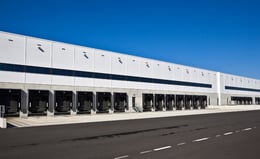Inventory Management and Trade-Offs in Today’s Supply Chain
Nick Ostdick - June 14, 2016

In today’s global, increasingly complex supply networking, companies are continuously forced to weigh and balance key trade-offs when it comes to managing inventory and adhering to planned production schedules in order to meet customer demand delivery timetables.
This for that. X for Y. If this happens, then that happens.
These are the scenarios manufacturing and suppliers must game when looking to create end-to-end (E2E) visibility and transparency across all touch points of the value chain, particularly in variant-rich industries with facilities and hubs scattered across the globe.
Think of today’s supply stream as a knot in a piece of string - pulling on one side of the knot affects the other. So many processes and strategies are interconnected that cutting through this complexity to create (E2E) visibility is a delicate process with a lot of moving parts.
As such, implementing an effective - some might say lean or optimized - inventory management strategy is a core driver in mitigating many of the trade-offs companies face on a day-to-day basis. Whether weighing transportation costs, warehousing strategies, yard and container management, or the parameters of planned production processes, inventory management plays a key role in the strategic, planning, and operations aspects of a company’s production and supply stream, and companies that can leverage effective inventory management at each of these three levels will be well-positioned for enhanced productivity and growth in both the mid and long-term future.
Strategic
Perhaps the most conceptual level of thinking, inventory management at the strategic stage is designed to help inform the decisions and actions at the planning and operational levels. Strategic inventory management essentially involves creating a roadmap of sorts whereby manufacturers and suppliers can visualize production and supply goals and objectives to help make cost-effective, productivity-based decisions when it comes to planning, production, warehousing, and distribution. The strategic stage is also where companies must weigh and evaluate the metrics they plan to deploy for reviewing overall supply stream efficiency - speed, reliability, production capacity, lead times, fill rates, and other key reporting factors and data points.
For example, an OEM providing parts for an automotive company may place a high value on speed and production capacity over cost and overall asset efficiency in order to ensure the right parts are always on-hand at the right time for planned production schedules which may be modified or altered based on demand. Companies that structure their supply networks in this manner - from a standpoint of part or product availability - may sacrifice cost efficiency in order to combat the potentiality of supply disruptions or bottlenecks, which can severely damage the flow and movement of a manufacturer's upstream and downstream logistics strategy.
Planning
Piggybacking on some of the tenets of inventory management at the strategic level, inventory management at the planning level involves more focussed, day-to-day discussions of ensuring the right parts are at the right place at the right time to maintain planned production schedules and account for possible alterations or modifications in demand planning. Whereas strategic inventory management is more of a holistic, global look at a company’s value chain, the planning level of inventory management dials in on the strategies and solutions necessary for short and mid-term planning logistics.
For inventory management strategy at the planning level to be a true value proposition, companies must incorporate sales and operations planning (S&OP) principles to help drive a balance between supply and demand and ensure inventory remains at levels necessary for continued production. Logistics like S&OP must be part of the process to evaluate the feasibility of demands on the supply network and to communicate this data to those at crucial touch points across a company’s value chain. In doing so, companies will avoid creating cross-functional silos which can hamper a company’s ability to foster an agile, responsive supply stream capable of weathering potential breakdowns or bottlenecks.
Operations
At the operations level of inventory management, key supply logistics such as warehouse strategy, allocation, sequencing, order-slotting, and others drive the decision-making processes companies deploy in making sure the right parts arrive at the right place at the right time. The operations level is where the rubber meets the road in terms of executing inventory management strategies that align with a company’s overall supply chain philosophy - the path set forth at the strategic stage - and the inventory strategy companies leverage on a day-to-day basis - the framework established at the planning stage.
The operations stage is also where companies must leverage technological platforms in order to facilitate the rules established in the strategic and planning stages. Optimized demand planning processes and solutions such as Plan for Every Part (PFEP), optimized inventory management software, and others are at the core of the operations stage, and companies can ill-afford to utilize these solutions in fostering E2E visibility, agility, and transparency.
As you can see, managing inventory and negotiating trade-offs in today’s global supply stream is no easy task - in fact, successfully navigating these concepts requires a multi-pronged approach to inventory management that necessitates decision-making on a macro and micro level. However, as evidenced by the growth and expansion of the worldwide supply network, these logistical concerns are critical for companies to remain viable and competitive.
If you want to learn more, download your guide to Transformation of Manufacturing Processes.
In this Guide you will learn:
-
Emerging Challenges in the Modern Truck/Automotive Industry
-
How Can Global Companies Adapt to These New Realities
-
How Decentralized Digital Systems Power Smarter Planning Processes
-
How flexis Can Support Flexible Supply Chain Transformation
LATEST POSTS
- Understand Circular Economy in The Manufacturing Industry
- How Can Industry 4.0 IT Integration Be Achieved Smoothly?
- The Significance of Order Sequencing in Discrete Manufacturing
- How to improve your Supply Chain Management: The Power of Control Towers
- Optimizing Human Resource Scheduling in Manufacturing: A Technological Approach



